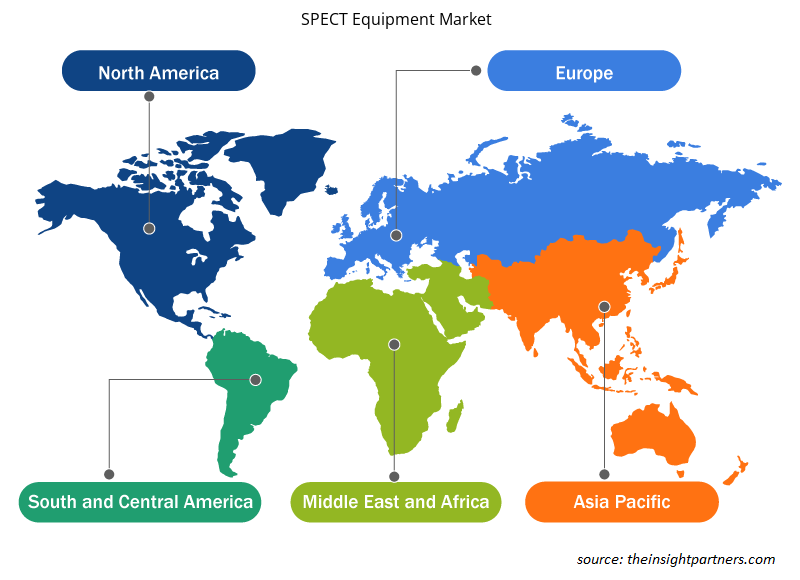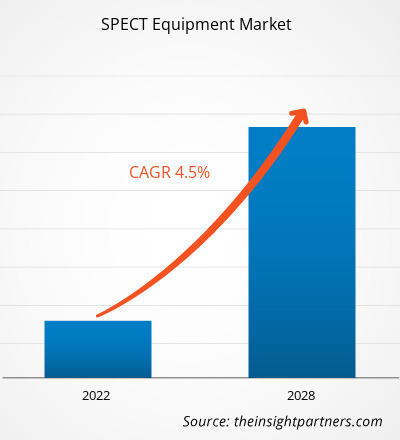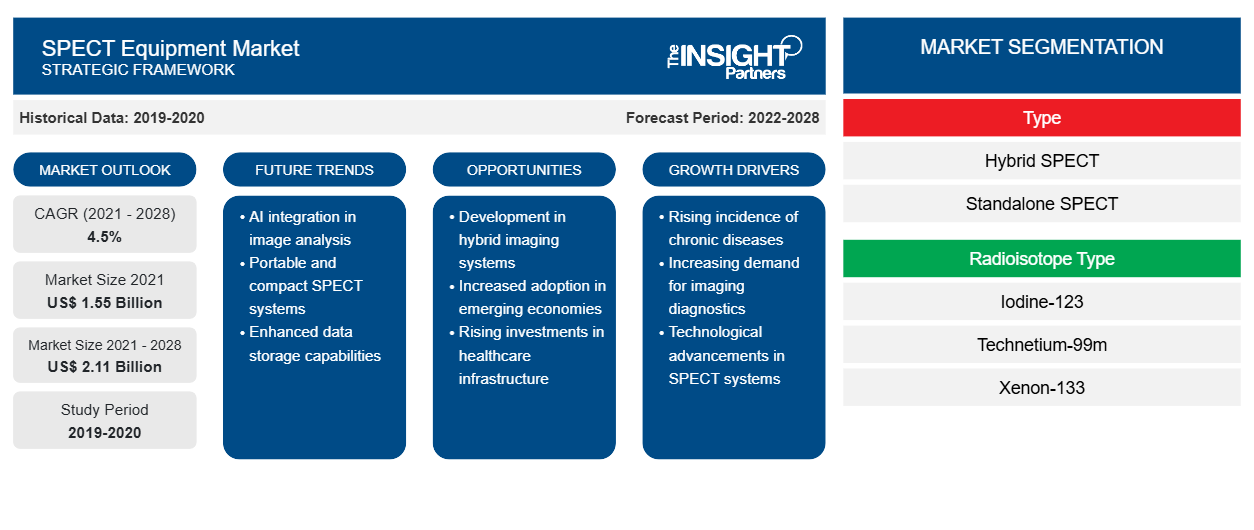Der Markt für SPECT -Geräte soll von 1.552,02 Millionen US-Dollar im Jahr 2021 auf 2.109,05 Millionen US-Dollar im Jahr 2028 anwachsen; von 2021 bis 2028 wird mit einer durchschnittlichen jährlichen Wachstumsrate von 4,5 % gerechnet.
SPECT ist eine Bildgebungstechnik, mit der physiologische Veränderungen in Organen und Geweben im Körper festgestellt werden können. SPECT unterstützt die Frühdiagnose von Erkrankungen, die Überwachung von Therapien oder auch die Erforschung der menschlichen Physiologie. Standalone- SPECT ist eine Klasse nuklearmedizinischer Bildgebungssysteme, die Gammastrahlen verwenden. Das Gerät erkennt die Gammastrahlenentladungen eines injizierten Radioisotops, um Bilder für Diagnose- und Krankheitsbehandlungszwecke zu erzeugen, da es in Echtzeit qualitativ hochwertige Ganzkörper-Tomographiebilder erstellen kann. Hybrid- SPECT ist ein Hybrid der beiden Bildgebungstechnologien, bei dem sowohl Gammakamera als auch PET-Geräte zusammen zur Bildaufzeichnung verwendet werden. Es verbessert die Bildqualität und reduziert gleichzeitig die Strahlendosis für die Patienten, die diesen Scans ständig ausgesetzt sind, insbesondere in der Onkologie.
Der Bericht bietet Einblicke und eine eingehende Analyse des SPECT- Gerätemarktes und hebt dabei verschiedene Parameter wie Markttrends, technologische Fortschritte, Marktdynamik und Wettbewerbslandschaftsanalysen führender Marktteilnehmer weltweit hervor. Er umfasst auch die Auswirkungen der COVID-19-Pandemie auf den Markt in allen Regionen. Die Pandemie hat die sozioökonomischen Bedingungen verschiedener Länder auf der ganzen Welt gestört. Derzeit sind die USA aufgrund des COVID-19-Ausbruchs das am schlimmsten betroffene Land der Welt mit der höchsten Anzahl bestätigter Fälle und Todesfälle, wie aus den jüngsten WHO-Statistiken hervorgeht. Die hohe Anzahl positiver COVID-19-Fälle hat sich negativ auf die Weltwirtschaft ausgewirkt. Es gab einen Rückgang der gesamten Geschäftstätigkeit und des Wachstums verschiedener weltweit tätiger Branchen.
Laut der Society of Nuclear Medicine and Molecular Imaging ( SNMMI ) verzeichneten fast 80 % der Befragten einen Rückgang von 50 % bis 75 % bei nuklearmedizinischen Bildgebungsverfahren. In den USA wurden die Diagnose- und Bildgebungsaktivitäten aufgrund einer steigenden Zahl von COVID-19-infizierten Patienten und tödlichen Coronavirus-Varianten während der Pandemie eingestellt. Daher verzögerte sich die Diagnose chronischer Krankheiten mit SPECT -Geräten insgesamt und behinderte den nordamerikanischen SPECT- Gerätemarkt. Daher hat die COVID-19-Pandemie potenzielle wirtschaftliche Auswirkungen auf die meisten Sektoren, beispielsweise auf onkologische Verfahren. Die Pandemie hat die Krebsdiagnose und -operationen behindert und wird sich in den kommenden Jahren wahrscheinlich negativ auf den Markt auswirken.
Nach Regionen gegliedert ist der Markt für SPECT -Geräte in Nordamerika, Europa, Asien-Pazifik, den Nahen Osten und Afrika sowie Süd- und Mittelamerika.
Passen Sie diesen Bericht Ihren Anforderungen an
Sie erhalten kostenlose Anpassungen an jedem Bericht, einschließlich Teilen dieses Berichts oder einer Analyse auf Länderebene, eines Excel-Datenpakets sowie tolle Angebote und Rabatte für Start-ups und Universitäten.
-
Holen Sie sich die wichtigsten Markttrends aus diesem Bericht.Dieses KOSTENLOSE Beispiel umfasst eine Datenanalyse von Markttrends bis hin zu Schätzungen und Prognosen.
Markteinblicke
Fortschritte in der Analyse der Tumorbildgebung
Gallium-67 ist der Goldstandard für die Tumordiagnose und -stadienbestimmung. Hybridbildgebung mit Ga-67 SPECT /CT ermöglicht die Lokalisierung von Lymphomläsionen. Ga-67 wird hauptsächlich zur Bildgebung von Entzündungen verwendet, da es sich in entzündeten Bereichen unspezifisch als Metall-Transferrin- Komplex ansammeln und anschließend weiter an Transferrinrezeptoren binden kann . Einige der Marktteilnehmer, die Galliumcitrat GA -67 anbieten, sind Lantheus Medical Imaging und Mallinckrodt Nuclear. Die diagnostische Bildgebung hat bei der Behandlung von Krebspatienten eine wichtige Rolle gespielt und mit der Einführung von Fusionstechniken in diesem Bereich einen weiteren Schritt nach vorne gemacht. Die SPECT- Technologie liefert Hybridbilder aus zwei unabhängigen Modalitäten, einer funktionellen Szintigraphietechnik und einem anatomischen Verfahren, wodurch eine überlegene Bildgebungsstudie entsteht. Die Szintigraphie basiert auf der Verwendung von Tracern, die einzelne Photonen oder Positronen emittieren und so eine Beschreibung von Funktionen oder Prozessen liefern, während Computertomographie (CT), Ultraschall oder Magnetresonanztomographie (MRT) die genaue Lokalisierung und Art der morphologischen Veränderungen darstellen, die in den Läsionen aufgetreten sind. Nach Angaben der Internationalen Agentur für Krebsforschung ( IARC ) wird die Zahl der neuen Krebsfälle bis 2040 auf 27,5 Millionen steigen. Zudem wird erwartet, dass die weltweite Krebsbelastung in den nächsten 20 Jahren um 70 % zunehmen wird.
Die Einführung eines Hybrid-Bildgebungsgeräts (das ein Niedrigdosis-CT-System und eine Gammakamera auf einem einzigen Stativ enthält) ermöglichte die sequentielle Erfassung der beiden Bildgebungsverfahren, wobei die anschließenden Daten zu einer zusammengesetzten Bildanzeige zusammengeführt wurden. Beispielsweise hilft die Gammakamera-SPECT-CT bei der Krebsdiagnose und wird in Schwellenländern wie Indien eingesetzt. Das Krankenhaus der indischen Marine INHS Asvini verfügt in Süd-Mumbai über eine hochmoderne Gammakamera-SPECT-CT. Solche Fortschritte bei den Erkennungsmethoden dürften die Krebsrate senken.
Typbasierte Erkenntnisse
Basierend auf dem Produkt ist der SPECT-Gerätemarkt in Hybrid-SPECT und Standalone-SPECT unterteilt. Das Hybrid-SPECT-Segment hatte einen größeren Marktanteil. Der Markt für das Hybrid-SPECT-Segment ist weiter unterteilt in SPECT-CT und SPECT-MR.
Erkenntnisse auf Basis von Radioisotopentypen
Basierend auf dem Radioisotopentyp ist der SPECT-Gerätemarkt in Jod-123, Technetium-99m, Xenon-133, Thallium-201, Radium-223, Gallium-66 und andere unterteilt. Das Technetium-99m-Segment hatte 2021 den größten Marktanteil, während das Gallium-66-Segment im Prognosezeitraum voraussichtlich die höchste durchschnittliche jährliche Wachstumsrate auf dem Markt verzeichnen wird.
Anwendungsbasierte Erkenntnisse
Basierend auf der Anwendung ist der Markt für SPECT-Geräte in Krampfanfälle, Schlaganfälle, Stressfrakturen, Infektionen, Tumore und andere unterteilt. Im Jahr 2021 hatte das Schlaganfallsegment den größten Marktanteil. Darüber hinaus wird erwartet, dass das Tumorsegment von 2021 bis 2028 die höchste durchschnittliche jährliche Wachstumsrate verzeichnet.
Endbenutzerbasierte Erkenntnisse
Basierend auf dem Endverbraucher ist der Markt für SPECT-Geräte in Krankenhäuser, Bildgebungszentren und andere unterteilt. Das Segment Krankenhäuser hatte 2021 den größten Marktanteil, und das Segment Bildgebungszentren dürfte im Prognosezeitraum die höchste durchschnittliche jährliche Wachstumsrate des Marktes verzeichnen.
Die Akteure auf dem SPECT-Gerätemarkt verfolgen organische Strategien wie Produkteinführung und -erweiterung, um ihre Präsenz und ihr Produktportfolio weltweit zu erweitern und der wachsenden Nachfrage gerecht zu werden.
Regionale Einblicke in den SPECT-Gerätemarkt
Die regionalen Trends und Faktoren, die den SPECT-Gerätemarkt während des Prognosezeitraums beeinflussen, wurden von den Analysten von Insight Partners ausführlich erläutert. In diesem Abschnitt werden auch die Marktsegmente und die Geografie von SPECT-Geräten in Nordamerika, Europa, im asiatisch-pazifischen Raum, im Nahen Osten und Afrika sowie in Süd- und Mittelamerika erörtert.

- Erhalten Sie regionale Daten zum SPECT-Gerätemarkt
Umfang des SPECT-Geräte-Marktberichts
| Berichtsattribut | Details |
|---|---|
| Marktgröße im Jahr 2021 | 1,55 Milliarden US-Dollar |
| Marktgröße bis 2028 | 2,11 Milliarden US-Dollar |
| Globale CAGR (2021 - 2028) | 4,5 % |
| Historische Daten | 2019-2020 |
| Prognosezeitraum | 2022–2028 |
| Abgedeckte Segmente |
Nach Typ
|
| Abgedeckte Regionen und Länder |
Nordamerika
|
| Marktführer und wichtige Unternehmensprofile |
|
Dichte der Marktteilnehmer für SPECT-Geräte: Auswirkungen auf die Geschäftsdynamik verstehen
Der Markt für SPECT-Geräte wächst rasant. Dies wird durch die steigende Nachfrage der Endnutzer aufgrund von Faktoren wie sich entwickelnden Verbraucherpräferenzen, technologischen Fortschritten und einem größeren Bewusstsein für die Vorteile des Produkts vorangetrieben. Mit der steigenden Nachfrage erweitern Unternehmen ihr Angebot, entwickeln Innovationen, um die Bedürfnisse der Verbraucher zu erfüllen, und nutzen neue Trends, was das Marktwachstum weiter ankurbelt.
Die Marktteilnehmerdichte bezieht sich auf die Verteilung der Firmen oder Unternehmen, die in einem bestimmten Markt oder einer bestimmten Branche tätig sind. Sie gibt an, wie viele Wettbewerber (Marktteilnehmer) in einem bestimmten Marktraum im Verhältnis zu seiner Größe oder seinem gesamten Marktwert präsent sind.
Die wichtigsten auf dem SPECT-Gerätemarkt tätigen Unternehmen sind:
- Cardinal Health, Inc.
- Curium
- Lantheus Medical Imaging, Inc.
- Mediso GmbH
- NTP-Radioisotope
Haftungsausschluss : Die oben aufgeführten Unternehmen sind nicht in einer bestimmten Reihenfolge aufgeführt.

- Überblick über die wichtigsten Akteure auf dem SPECT-Gerätemarkt
Der Markt für SPECT-Geräte ist wie folgt segmentiert:
Der SPECT-Gerätemarkt ist nach Typ, Radioisotopentyp, Anwendung, Endbenutzer und Geografie segmentiert. Nach Typ ist der Markt in Hybrid-SPECT und Standalone-SPECT unterteilt. Der Markt für das Hybrid-SPECT-Segment ist weiter unterteilt in SPECT-CT und SPECT-MR. Nach Radioisotopentyp ist der SPECT-Gerätemarkt in Jod-123, Technetium-99m, Xenon-133, Thallium-201, Radium-223, Gallium-66 und Sonstiges segmentiert. Nach Anwendung ist der Markt in Krampfanfälle, Schlaganfälle, Ermüdungsbrüche, Infektionen, Tumore und Sonstiges segmentiert. Nach Endbenutzer ist der SPECT-Gerätemarkt in Krankenhäuser, Bildgebungszentren und Sonstiges segmentiert. Nach Geografie ist der Markt in Nordamerika, Europa, Asien-Pazifik (APAC), Naher Osten und Afrika (MEA) sowie Süd- und Mittelamerika (SCAM) segmentiert. Der SPECT-Gerätemarkt in Nordamerika ist in die USA, Kanada und Mexiko unterteilt. Der Markt in Europa ist weiter unterteilt in Frankreich, Deutschland, Großbritannien, Spanien, Italien und den Rest von Europa. Der SPECT-Gerätemarkt im asiatisch-pazifischen Raum (APAC) ist weiter unterteilt in China, Indien, Japan, Australien, Südkorea und den Rest des asiatisch-pazifischen Raums. Der Markt im Nahen Osten und Afrika (MEA) ist weiter unterteilt in Saudi-Arabien, die Vereinigten Arabischen Emirate, Südafrika und den Rest des Nahen Ostens und Afrikas. Der SPECT-Gerätemarkt in Süd- und Mittelamerika (SCAM) ist weiter unterteilt in Brasilien, Argentinien und den Rest von Süd- und Mittelamerika. Zu den in unserem Forschungsumfang enthaltenen Unternehmen zählen Cardinal Health Inc, Curium und Lantheus Medical Imaging, Inc.
,
Mediso GmbH
,
NTP-Radioisotope
,
Bracco Imaging SpA, Star Equity Holdings, Inc.
,
Unter anderem Bruker Corporation, MiE GmbH und Spectrum Dynamics Medical.
- Historische Analyse (2 Jahre), Basisjahr, Prognose (7 Jahre) mit CAGR
- PEST- und SWOT-Analyse
- Marktgröße Wert/Volumen – Global, Regional, Land
- Branchen- und Wettbewerbslandschaft
- Excel-Datensatz
Aktuelle Berichte
Erfahrungsberichte
Grund zum Kauf
- Fundierte Entscheidungsfindung
- Marktdynamik verstehen
- Wettbewerbsanalyse
- Kundeneinblicke
- Marktprognosen
- Risikominimierung
- Strategische Planung
- Investitionsbegründung
- Identifizierung neuer Märkte
- Verbesserung von Marketingstrategien
- Steigerung der Betriebseffizienz
- Anpassung an regulatorische Trends























 Kostenlose Probe anfordern für - SPECT-Gerätemarkt
Kostenlose Probe anfordern für - SPECT-Gerätemarkt